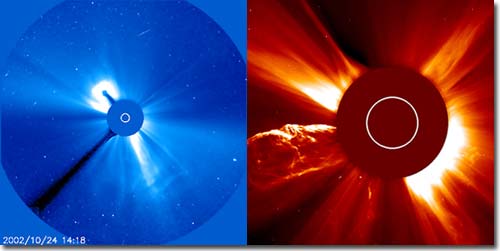Corona... Gasp!
In late October 2002, the time that some parts of the world were observing autumn’s explosion of color, the Sun gave a colorful show of its own to solar physicists. These two images were recorded using coronagraphs mounted onboard the Solar and Heliospheric Observatory spacecraft. Coronagraphs are special instruments used to study the Sun’s outer atmosphere, the corona. This is the part of the Sun that is easily visible from the Earth during a solar eclipse. (Note: You should NEVER look directly at the Sun during an eclipse). A coronagraph has a disk which blocks direct light from the Sun, allowing the dimmer corona to be seen. These images show coronal mass ejections (CMEs), immense eruptions of plasma from the Sun. CMEs that are ejected out towards the Earth can cause spectacular auroral displays (see Plasma Power) and can also disrupt communication systems. The “keyhole” shape of the CME pictured on the left has never been seen before by solar physicists. The origin of this shape is believed to be a combination of effects from nearby solar structures, the position of the SOHO spacecraft, and image-processing techniques. The CME pictured on the right shows a twisted, corkscrew shape resulting from twisted solar magnetic fields.

Notes on the images:
- The images are from two of the three LASCO coronagraphs onboard SOHO.
- The color isn’t real. The images are color-coded so the scientists can tell them apart quickly.
- The white circles show the size and location of the Sun’s surface.
The Sun shows off its own fall explosion of color with massive bursts of plasma.
Image credit: Courtesy of SOHO/LASCO consortium. SOHO is a project of international cooperation between the European Space Agency (ESA) and NASA











